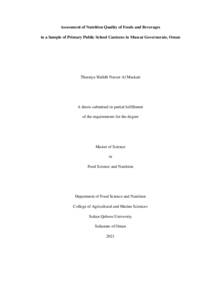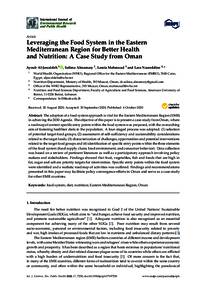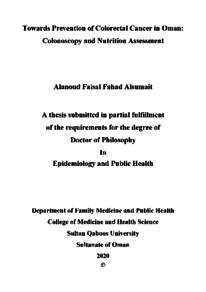Document
Assessment of nutrition quality of foods and beverages in a sample of primary public school canteens in Muscat Governorate, Oman.
Publisher
Sultan Qaboos University.
Gregorian
2021
Language
English
English abstract
Nutrition for school-aged children is a crucial aspect of their health.
Acquired nutritional habits could persist from childhood to adulthood and school is
an important environment in children nutrition. Therefore, research into the nutrition
quality of foods and beverages in school canteens is of utmost importance and it has
not been explored in Oman. The aim of this study was to assess compliance of foods
and beverages in primary public school canteens in Muscat Governorate to the
Omani Canteen Guidelines (OCG) and to assess their nutritional quality based on
various international guidelines.
This is a cross-sectional study of foods and beverages collected from 16
primary public schools in four districts in Muscat Governorate. Foods and beverages
were collected for five days from each school canteen before or during recess time.
All provided foods were collected and transported to Sultan Qaboos University
(SQU) for theoretical analysis of the nutritional quality. Foods and beverages were
compared to the OCG relevant lists to determine their compliance. The nutrition
quality of foods and beverages was assessed based on criteria of international
assessment guidelines (USDA Smart Snacks, Pan American Health Organization
Nutrient Profile Model (PAHO NPM), UK Nutrient Profiling Model (UK NPM) and
National Healthy School Canteen (NHSC) guidelines). Differences in compliance
and nutrition quality were examined in districts, categories of food and beverage and
canteen management approaches. Chi-square test of association was used to
compare the difference in compliance to the OCG within independent variables.
Friedman's test was used to compare the nutrition quality of foods and beverages
using different international assessment guidelines collectively and with respect to
their compliance to the OCG. Kruskal Wallis test was used to compare the nutrition
v
quality of foods and beverages between districts, categories of food and beverage and
canteen management approaches.
A total of 222 foods and 80 beverages were collected from 16 schools. All
the beverages were compliant with the OCG while only 37% of foods were
compliant. Significant differences in food compliance within districts (p < .05), food
categories (p < .001) and canteen approaches (p < .05) were observed. Only 4.5%,
0% and 2% of the foods and 0%, 2.5% and 22.5% of the beverages met all criteria of
nutrient quality of the USDA Smart Snacks, PAHO NPM and UK NPM,
respectively. Categorizing food and beverage samples based on NHSC guidelines
showed that 4.1% and 0%, respectively, were from the green category that represents
the highest nutrition quality. Controlling for compliance with the OCG, there was a
significant difference in nutrition quality of foods by different assessment methods (p
< .001). The pairwise comparison showed difference in all pairs except the USDA
Smart Snacks and the PAHO NPM in foods and in the pair PAHO NPM and UK
NPM for beverages. The nutrition quality of foods and beverages was similar in all
districts (p > .05).
Compliance of foods to the current OCG is low and the nutrition quality of
foods and beverages provided in the sampled primary public school canteens is very
low when assessed by international guidelines. The nutrition quality by PAHO NPM
showed similarity with other international guidelines, USDA Smart Snacks and UK
NPM. Therefore, the PAHO NPM can be adapted to regulate and monitor school
nutrition. These findings inform the policymakers about the status of the nutrition
quality of foods and beverages in public school canteens and provide practical
approaches to improve the status of school nutrition and therefore the wellbeing of
the school-aged children.
Member of
Resource URL
Arabic abstract
المقدمة: اضطرابات طيف التوحد Autism Spectrum Disorders ASD هو اضطراب النمو العصبي ذو علاقة بمجالات محددة في الدماغ، ويؤثر في قدرات الطفل ومهاراته في مجال التواصل والتفاعل الاجتماعي ويتميز بالحركات النمطية المتكررة. ومن المعروف أن الأطفال الذين يعانون من التوحد لديهم العديد من المشاكل التغذية التي يعتقد أنها تؤثر على وضعهم الغذائي.
الأهداف: الهدف من هذه الدراسة هو تقييم الحالة الغذائية ومشاكل السلوك المتعلقة بالتغذية والطعام المفضل للأطفال المصابين باضطرابات طيف التوحد في سلطنة عمان.
الطريقة: شملت الدراسة 375 طفلا من كلا الجنسين تتراوح اعمارهم من 4 الى 13 سنة. عدد الاطفال المصابين باضطرابات الطيف التوحدي (ASD) 163 طفلا بينما كان عدد الاطفال الذين ينمون بشكل نمطي (TD)212 طفلا كعينة ضابطة. تم جمع معلومات من ثلاثة استبيانات متعلقة بالجوانب الديموغرافية و القياسات البشرية و تناول الأدوية والأغذية. تم تسجيل الطعام الذي تم تناوله لمدة 3 أيام و تسجيل سلوكيات الاطفال اثناء وقت الطعام (BAMBI) وتحديد الأطعمة المفضلة للطفل. علاوة على ذلك, تم تقييم تصورات لمقدمي الرعاية الاطفال في العديد من الجوانب التغذوية.
النتائج: كان هناك تشابه بين السمات الخاصة بالقائمين على الرعاية، بينما كان هناك اختلاف كبير حول وجهة نظرهم بشأن المعايير الغذائية المختلفة. كان هناك تشابه في المجموعات بين العمر وبين مؤشر كتلة الجسم، بينما كان عدد الذكور أعلى في مجموعة الأطفال المصابين باضطرابات طيف التوحد P < 0.001).). كان هناك تشابه بين المجموعتين من حيث تفاصيل الولادة، بينما كانت الرضاعة الطبيعية أقل و المدة اقصر في مجموعة ألأطفال المصابين باضطرابات طيف التوحد P < 0.001)). كان التاريخ الطبي بوجود أعراض معدية معوية مزمنة واستخدام الأودية والحمية المقيدة والفيتامينات والمعادن المكملة أعلى بشكل كبير لدى الأطفال المصابين باضطرابات طيف التوحد.
من بين مشاكل الأطفال ا السلوكية رفض الطعام والانتقائية وكذلك محدودية التنوع، وكانت هذه المشاكل واضحة بشكل كبير عند الأطفال المصابين باضطرابات طيف التوحد مقارنة بالأطفال العاديين. على الرغم من ذلك، فقد تبين أن الأطفال المصابين باضطرابات طيف التوحد يستهلكون معظم الأطباق العمانية التقليدية.
فيما يتعلق بالغذاء الذي يتم تناوله، كان الأطفال المصابون باضطرابات التوحد الطيفي أقل قدرة على الوصول إلى المعدل اليومي المطلوب للطاقة والكربوهيدرات والألياف. ومن حيث الفيتامينات، فقد أوضحت النتائج أن أكثر من %50 من الأطفال المصابين باضطرابات طيف التوحد لا يحقق المعدل الخاص بفيتامين (A) (%98)، فيتامين C)) (%56) وفيتامين D(84.5%) وفيتامين E (97.1%) و فيتامين K (%92.2).
علاوة على ذلك فإن تناول فيتامين B12 وفيتامين D عند الأطفال المصابين باضطرابات طيف التوحد كان أقل مقارنة بالأطفال العاديين. لم تحقق أي من المجموعتين المستوى المطلوب في كمية الحديد المطلوب تناولها يوميا ((OR = 1.44, 95% CI = (0.89- 2.33), p = 0.170 ، و كان الأطفال المصابون باضطرابات طيف التوحد أكثر عرضة مرتين لعدم الوصول إلى المستوى المطلوب من الكالسيوم من الطعام الذي يتم تناوله يوميا , P=0.003) (OR = 2.16, 95% CI = (1.31-3.54).
الخلاصة: هذه أول دراسة توفر معلومات حول عادات الأكل والتغذية لدى الأطفال المصابين باضطرابات طيف التوحد . النتائج العامة التي توصلت إليها الدراسة مشجعة وربما تساهم في مزيد من الفهم لسلوك التغذية وتناول الأطعمة المفضلة لهذه الفئة ومعدل المواد الغذائية والمعادن المناسب للأطفال المصابين باضطرابات طيف التوحد في سلطنة عمان. وتعتبر مثل هذه المعلومات ضرورية جدا للتحكم في، والوقاية من القصور في التغذية بين الأطفال المصابين بالتوحد.
الأهداف: الهدف من هذه الدراسة هو تقييم الحالة الغذائية ومشاكل السلوك المتعلقة بالتغذية والطعام المفضل للأطفال المصابين باضطرابات طيف التوحد في سلطنة عمان.
الطريقة: شملت الدراسة 375 طفلا من كلا الجنسين تتراوح اعمارهم من 4 الى 13 سنة. عدد الاطفال المصابين باضطرابات الطيف التوحدي (ASD) 163 طفلا بينما كان عدد الاطفال الذين ينمون بشكل نمطي (TD)212 طفلا كعينة ضابطة. تم جمع معلومات من ثلاثة استبيانات متعلقة بالجوانب الديموغرافية و القياسات البشرية و تناول الأدوية والأغذية. تم تسجيل الطعام الذي تم تناوله لمدة 3 أيام و تسجيل سلوكيات الاطفال اثناء وقت الطعام (BAMBI) وتحديد الأطعمة المفضلة للطفل. علاوة على ذلك, تم تقييم تصورات لمقدمي الرعاية الاطفال في العديد من الجوانب التغذوية.
النتائج: كان هناك تشابه بين السمات الخاصة بالقائمين على الرعاية، بينما كان هناك اختلاف كبير حول وجهة نظرهم بشأن المعايير الغذائية المختلفة. كان هناك تشابه في المجموعات بين العمر وبين مؤشر كتلة الجسم، بينما كان عدد الذكور أعلى في مجموعة الأطفال المصابين باضطرابات طيف التوحد P < 0.001).). كان هناك تشابه بين المجموعتين من حيث تفاصيل الولادة، بينما كانت الرضاعة الطبيعية أقل و المدة اقصر في مجموعة ألأطفال المصابين باضطرابات طيف التوحد P < 0.001)). كان التاريخ الطبي بوجود أعراض معدية معوية مزمنة واستخدام الأودية والحمية المقيدة والفيتامينات والمعادن المكملة أعلى بشكل كبير لدى الأطفال المصابين باضطرابات طيف التوحد.
من بين مشاكل الأطفال ا السلوكية رفض الطعام والانتقائية وكذلك محدودية التنوع، وكانت هذه المشاكل واضحة بشكل كبير عند الأطفال المصابين باضطرابات طيف التوحد مقارنة بالأطفال العاديين. على الرغم من ذلك، فقد تبين أن الأطفال المصابين باضطرابات طيف التوحد يستهلكون معظم الأطباق العمانية التقليدية.
فيما يتعلق بالغذاء الذي يتم تناوله، كان الأطفال المصابون باضطرابات التوحد الطيفي أقل قدرة على الوصول إلى المعدل اليومي المطلوب للطاقة والكربوهيدرات والألياف. ومن حيث الفيتامينات، فقد أوضحت النتائج أن أكثر من %50 من الأطفال المصابين باضطرابات طيف التوحد لا يحقق المعدل الخاص بفيتامين (A) (%98)، فيتامين C)) (%56) وفيتامين D(84.5%) وفيتامين E (97.1%) و فيتامين K (%92.2).
علاوة على ذلك فإن تناول فيتامين B12 وفيتامين D عند الأطفال المصابين باضطرابات طيف التوحد كان أقل مقارنة بالأطفال العاديين. لم تحقق أي من المجموعتين المستوى المطلوب في كمية الحديد المطلوب تناولها يوميا ((OR = 1.44, 95% CI = (0.89- 2.33), p = 0.170 ، و كان الأطفال المصابون باضطرابات طيف التوحد أكثر عرضة مرتين لعدم الوصول إلى المستوى المطلوب من الكالسيوم من الطعام الذي يتم تناوله يوميا , P=0.003) (OR = 2.16, 95% CI = (1.31-3.54).
الخلاصة: هذه أول دراسة توفر معلومات حول عادات الأكل والتغذية لدى الأطفال المصابين باضطرابات طيف التوحد . النتائج العامة التي توصلت إليها الدراسة مشجعة وربما تساهم في مزيد من الفهم لسلوك التغذية وتناول الأطعمة المفضلة لهذه الفئة ومعدل المواد الغذائية والمعادن المناسب للأطفال المصابين باضطرابات طيف التوحد في سلطنة عمان. وتعتبر مثل هذه المعلومات ضرورية جدا للتحكم في، والوقاية من القصور في التغذية بين الأطفال المصابين بالتوحد.
Category
Theses and Dissertations



